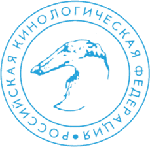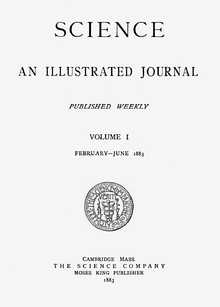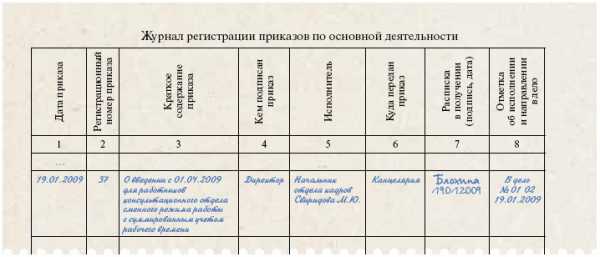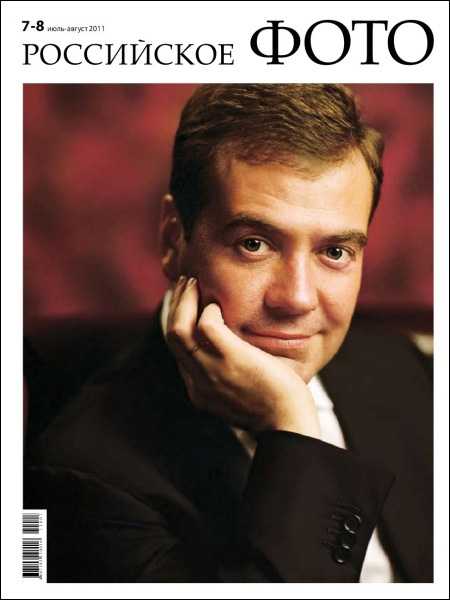Nature (journal). Журнал nature
Nature (journal) - Wikipedia
Nature is a British multidisciplinary scientific journal, first published on 4 November 1869.[1] It was ranked the world's most cited scientific journal by the Science Edition of the 2010 Journal Citation Reports and is ascribed an impact factor of 40.137 , making it one of the world's top academic journals.[2][3] It is one of the few remaining academic journals that publishes original research across a wide range of scientific fields.[3][4]
Research scientists are the primary audience for the journal, but summaries and accompanying articles are intended to make many of the most important papers understandable to scientists in other fields and the educated public. Towards the front of each issue are editorials, news and feature articles on issues of general interest to scientists, including current affairs, science funding, business, scientific ethics and research breakthroughs. There are also sections on books and arts. The remainder of the journal consists mostly of research papers (articles or letters), which are often dense and highly technical. Because of strict limits on the length of papers, often the printed text is actually a summary of the work in question with many details relegated to accompanying supplementary material on the journal's website.
There are many fields of research in which important new advances and original research are published as either articles or letters in Nature. The papers that have been published in this journal are internationally acclaimed for maintaining high research standards. Less than 8% of submitted papers are accepted for publication.[5]
In 2007 Nature (together with Science) received the Prince of Asturias Award for Communications and Humanity.[6][7]
History[edit]
Background[edit]
The enormous progress in science and mathematics during the 19th century was recorded in journals written mostly in German or French, as well as in English. Britain underwent enormous technological and industrial changes and advances particularly in the latter half of the 19th century.[8] In English the most respected scientific journals of this time were the refereed journals of the Royal Society, which had published many of the great works from Isaac Newton, Michael Faraday through to early works from Charles Darwin. In addition, during this period, the number of popular science periodicals doubled from the 1850s to the 1860s.[9] According to the editors of these popular science magazines, the publications were designed to serve as "organs of science", in essence, a means of connecting the public to the scientific world.[9]
Nature, first created in 1869, was not the first magazine of its kind in Britain. One journal to precede Nature was Recreative Science: A Record and Remembrancer of Intellectual Observation, which, created in 1859, began as a natural history magazine and progressed to include more physical observational science and technical subjects and less natural history.[10] The journal's name changed from its original title to Intellectual Observer: A Review of Natural History, Microscopic Research, and Recreative Science and then later to the Student and Intellectual Observer of Science, Literature, and Art.[11] While Recreative Science had attempted to include more physical sciences such as astronomy and archaeology, the Intellectual Observer broadened itself further to include literature and art as well.[11] Similar to Recreative Science was the scientific journal Popular Science Review, created in 1862,[12] which covered different fields of science by creating subsections titled "Scientific Summary" or "Quarterly Retrospect", with book reviews and commentary on the latest scientific works and publications.[12] Two other journals produced in England prior to the development of Nature were the Quarterly Journal of Science and Scientific Opinion, established in 1864 and 1868, respectively.[11] The journal most closely related to Nature in its editorship and format was The Reader, created in 1864; the publication mixed science with literature and art in an attempt to reach an audience outside of the scientific community, similar to Popular Science Review.[11]
These similar journals all ultimately failed. The Popular Science Review survived longest, lasting 20 years and ending its publication in 1881; Recreative Science ceased publication as the Student and Intellectual Observer in 1871. The Quarterly Journal, after undergoing a number of editorial changes, ceased publication in 1885. The Reader terminated in 1867, and finally, Scientific Opinion lasted a mere 2 years, until June 1870.[10]
Creation[edit]
First title page, 4 November 1869Not long after the conclusion of The Reader, a former editor, Norman Lockyer, decided to create a new scientific journal titled Nature,[13] taking its name from a line by William Wordsworth: "To the solid ground of nature trusts the Mind that builds for aye".[14] First owned and published by Alexander Macmillan, Nature was similar to its predecessors in its attempt to "provide cultivated readers with an accessible forum for reading about advances in scientific knowledge."[13] Janet Browne has proposed that "far more than any other science journal of the period, Nature was conceived, born, and raised to serve polemic purpose."[13] Many of the early editions of Nature consisted of articles written by members of a group that called itself the X Club, a group of scientists known for having liberal, progressive, and somewhat controversial scientific beliefs relative to the time period.[13] Initiated by Thomas Henry Huxley, the group consisted of such important scientists as Joseph Dalton Hooker, Herbert Spencer, and John Tyndall, along with another five scientists and mathematicians; these scientists were all avid supporters of Darwin's theory of evolution as common descent, a theory which, during the latter half of the 19th century, received a great deal of criticism among more conservative groups of scientists.[15] Perhaps it was in part its scientific liberality that made Nature a longer-lasting success than its predecessors. John Maddox, editor of Nature from 1966 to 1973 as well as from 1980 to 1995, suggested at a celebratory dinner for the journal's centennial edition that perhaps it was the journalistic qualities of Nature that drew readers in; "journalism" Maddox states, "is a way of creating a sense of community among people who would otherwise be isolated from each other. This is what Lockyer's journal did from the start."[16] In addition, Maddox mentions that the financial backing of the journal in its first years by the Macmillan family also allowed the journal to flourish and develop more freely than scientific journals before it.[16]
Editors[edit]
Norman Lockyer, the founder of Nature, was a professor at Imperial College. He was succeeded as editor in 1919 by Sir Richard Gregory.[17] Gregory helped to establish Nature in the international scientific community. His obituary by the Royal Society stated: "Gregory was always very interested in the international contacts of science, and in the columns of Nature he always gave generous space to accounts of the activities of the International Scientific Unions."[18] During the years 1945 to 1973, editorship of Nature changed three times, first in 1945 to A. J. V. Gale and L. J. F. Brimble (who in 1958 became the sole editor), then to John Maddox in 1965, and finally to David Davies in 1973.[17] In 1980, Maddox returned as editor and retained his position until 1995. Philip Campbell has since become Editor-in-chief of all Nature publications.[17]
Expansion and development[edit]
In 1970, Nature first opened its Washington office; other branches opened in New York in 1985, Tokyo and Munich in 1987, Paris in 1989, San Francisco in 2001, Boston in 2004, and Hong Kong in 2005. In 1971, under John Maddox's editorship, the journal split into Nature Physical Sciences (published on Mondays), Nature New Biology (published on Wednesdays) and Nature (published on Fridays). In 1974, Maddox was no longer editor, and the journals were merged into Nature.[19]
Starting in the 1980s, the journal underwent a great deal of expansion, launching over ten new journals. These new journals comprise the Nature Publishing Group, which was created in 1999 and includes Nature, Nature Publishing Group Journals, Stockton Press Specialist Journals and Macmillan Reference (renamed NPG Reference).
In 1996, Nature created its own website[20] and in 1999 Nature Publishing Group began its series of Nature Reviews.[17] Some articles and papers are available for free on the Nature website. Others require the purchase of premium access to the site. Nature claims an online readership of about 3 million unique readers per month.[21]
On 30 October 2008, Nature endorsed an American presidential candidate for the first time when it supported Barack Obama during his campaign in America's 2008 presidential election.[22][23]
In October 2012, an Arabic edition of the magazine was launched in partnership with King Abdulaziz City for Science and Technology. As of the time it was released, it had about 10,000 subscribers.[24]
On 2 December 2014, Nature announced that it would allow its subscribers and a group of selected media outlets to share links allowing free, "read-only" access to content from its journals. These articles are presented using the digital rights management system ReadCube (which is funded by the Macmillan subsidiary Digital Science), and does not allow readers to download, copy, print, or otherwise distribute the content. While it does, to an extent, provide free online access to articles, it is not a true open access scheme due to its restrictions on re-use and distribution.[25][26]
On 15 January 2015, details of a proposed merger with Springer Science+Business Media were announced.[27]
In May 2015 it came under the umbrella of Springer Nature, by the merger of Springer Science+Business Media and Holtzbrinck Publishing Group's Nature Publishing Group, Palgrave Macmillan, and Macmillan Education.[28]
Publishing of articles[edit]
Having a paper (article or letter) published in Nature or any Nature publication such as Nature chemistry or Nature chemical biology is very prestigious, and the papers are often highly cited, which can lead to promotions, grant funding, and attention from the mainstream media. Because of these positive feedback effects, competition among scientists to publish in high-level journals like Nature and its closest competitor, Science, can be very fierce. Nature's impact factor, a measure of how many citations a journal generates in other works, was 38.138 in 2015 (as measured by Thomson ISI), among the highest of any science journal.
As with most other professional scientific journals, papers undergo an initial screening by the editor, followed by peer review (in which other scientists, chosen by the editor for expertise with the subject matter but who have no connection to the research under review, will read and critique articles), before publication. In the case of Nature, they are only sent for review if it is decided that they deal with a topical subject and are sufficiently ground-breaking in that particular field. As a consequence, the majority of submitted papers are rejected without review.
According to Nature's original mission statement:
It is intended, FIRST, to place before the general public the grand results of Scientific Work and Scientific Discovery; and to urge the claims of Science to a more general recognition in Education and in Daily Life; and, SECONDLY, to aid Scientific men themselves, by giving early information of all advances made in any branch of Natural knowledge throughout the world, and by affording them an opportunity of discussing the various Scientific questions which arise from time to time.[29]
This was revised in 2000 to:
First, to serve scientists through prompt publication of significant advances in any branch of science, and to provide a forum for the reporting and discussion of news and issues concerning science. Second, to ensure that the results of science are rapidly disseminated to the public throughout the world, in a fashion that conveys their significance for knowledge, culture and daily life.[30]
Landmark papers[edit]
Many of the most significant scientific breakthroughs in modern history have been first published in Nature. The following is a selection of scientific breakthroughs published in Nature, all of which had far-reaching consequences, and the citation for the article in which they were published.
Controversies[edit]
In 2017, Nature published an editorial entitled "Removing Statues of Historical figures risks whitewashing history: Science must acknowledge mistakes as it marks its past". The article commented on the placement and maintenance of statues honouring scientists with known unethical, abusive and torturous histories. Specifically, the editorial called on examples of J. Marion Sims, the 'Father of gynecology' who experimented on African American women (slaves) without their consent, and Thomas Parran Jr. who oversaw the Tuskegee syphilis experiment. The editorial as written made the case that removing such statues, and erasing names, runs the risk of "whitewashing history", and stated “Instead of removing painful reminders, perhaps these should be supplemented”. The article caused a large outcry and was quickly modified by Nature.[31] The article was largely seen as offensive, inappropriate, and by many, racist. Nature acknowledged that the article as originally written was "offensive and poorly worded" and published selected letters of response.[32] The editorial came just weeks after hundreds of white supremacists marched in Charlottesville, Virginia in the Unite the Right rally to oppose the removal of a statue of Robert E. Lee, setting off violence in the streets and killing a young woman. When Nature posted a link to the editorial on Twitter, the thread quickly exploded with criticisms. In response, several scientists called for a boycott.[33] On 18 September 2017, the editorial was updated and edited by Philip Campbell, the editor of the journal.[34]
When Paul Lauterbur and Peter Mansfield won a Nobel Prize in Physiology or Medicine for research initially rejected by Nature and published only after Lauterbur appealed the rejection, Nature acknowledged more of its own missteps in rejecting papers in an editorial titled, "Coping with Peer Rejection":
[T]here are unarguable faux pas in our history. These include the rejection of Cherenkov radiation, Hideki Yukawa's meson, work on photosynthesis by Johann Deisenhofer, Robert Huber and Hartmut Michel, and the initial rejection (but eventual acceptance) of Stephen Hawking's black-hole radiation.[35]
From 2000 to 2001, a series of five fraudulent papers by Jan Hendrik Schön was published in Nature. The papers, about semiconductors, were revealed to contain falsified data and other scientific fraud. In 2003, Nature retracted the papers. The Schön scandal was not limited to Nature; other prominent journals, such as Science and Physical Review, also retracted papers by Schön.[36]
In June 1988, after nearly a year of guided scrutiny from its editors, Nature published a controversial and seemingly anomalous paper detailing Dr. Jacques Benveniste and his team's work studying human basophil degranulation in the presence of extremely dilute antibody serum.[37] In short, their paper concluded that less than a single molecule of antibody could trigger an immune response in human basophils, defying the physical law of mass action. The paper excited substantial media attention in Paris, chiefly because their research sought funding from homeopathic medicine companies. Public inquiry prompted Nature to mandate an extensive, stringent and scientifically questionable experimental replication in Benveniste's lab, through which his team's results were categorically disputed.[38]
Before publishing one of its most famous discoveries, Watson and Crick's 1953 paper on the structure of DNA, Nature did not send the paper out for peer review. John Maddox, Nature's editor, stated: "the Watson and Crick paper was not peer-reviewed by Nature ... the paper could not have been refereed: its correctness is self-evident. No referee working in the field ... could have kept his mouth shut once he saw the structure".[39]
An earlier error occurred when Enrico Fermi submitted his breakthrough paper on the weak interaction theory of beta decay. Nature turned down the paper because it was considered too remote from reality.[40] Fermi's paper was published by Zeitschrift für Physik in 1934,[41] and finally published by Nature five years later,[citation needed] after Fermi's work had been widely accepted.
Science fiction[edit]
In 1999 Nature began publishing science fiction short stories. The brief "vignettes" are printed in a series called "Futures". The stories appeared in 1999 and 2000, again in 2005 and 2006, and have appeared weekly since July 2007.[42] Sister publication Nature Physics also printed stories in 2007 and 2008.[43] In 2005, Nature was awarded the European Science Fiction Society's Best Publisher award for the "Futures" series.[44] One hundred of the Nature stories between 1999 and 2006 were published as the collection Futures from Nature in 2008.[45]
Publication[edit]
The journal has a weekly circulation of around 53,000 and a pass-along rate of 8.0,[46] resulting in a readership of over 400,000.[47]
Nature is edited and published in the United Kingdom by a division of the international scientific publishing company Springer Nature that publishes academic journals, magazines, online databases, and services in science and medicine. Nature has offices in London, New York City, San Francisco, Washington, D.C., Boston, Tokyo, Hong Kong, Paris, Munich, and Basingstoke. Nature Publishing Group also publishes other specialized journals including Nature Neuroscience, Nature Biotechnology, Nature Methods, the Nature Clinical Practice series of journals, Nature Structural & Molecular Biology, Nature Chemistry, and the Nature Reviews series of journals.
Since 2005, each issue of Nature has been accompanied by a Nature Podcast[48] featuring highlights from the issue and interviews with the articles' authors and the journalists covering the research. It is presented by Kerri Smith, and features interviews with scientists on the latest research, as well as news reports from Nature's editors and journalists. The Nature Podcast was founded – and the first 100 episodes were produced and presented – by clinician and virologist Chris Smith of Cambridge and The Naked Scientists.
In 2007, Nature Publishing Group began publishing Clinical Pharmacology & Therapeutics, the official journal of the American Society of Clinical Pharmacology & Therapeutics and Molecular Therapy, the American Society of Gene Therapy's official journal, as well as the International Society for Microbial Ecology (ISME) Journal. Nature Publishing Group launched Nature Photonics in 2007 and Nature Geoscience in 2008. Nature Chemistry published its first issue in April 2009.
Nature Publishing Group actively supports the self-archiving process and in 2002 was one of the first publishers to allow authors to post their contributions on their personal websites, by requesting an exclusive licence to publish, rather than requiring authors to transfer copyright. In December 2007, Nature Publishing Group introduced the Creative Commons attribution-non commercial-share alike unported licence for those articles in Nature journals that are publishing the primary sequence of an organism's genome for the first time.[49]
In 2008, a collection of articles from Nature was edited by John S. Partington under the title H. G. Wells in Nature, 1893–1946: A Reception Reader and published by Peter Lang.[50]
Notes and references[edit]
- ^ Huxley, T. H. (1869). "Nature: Aphorisms by Goethe". Nature. 1: 9–11. Bibcode:1869Natur...1....9H. doi:10.1038/001009a0.
- ^ Fersht, Alan (2009-04-28). "The most influential journals: Impact Factor and Eigenfactor". Proceedings of the National Academy of Sciences. 106 (17): 6883–6884. Bibcode:2009PNAS..106.6883F. doi:10.1073/pnas.0903307106. ISSN 0027-8424. PMC 2678438 . PMID 19380731.
- ^ a b "About Nature". nature.com. Retrieved 12 August 2011.
- ^ "Nature vs science: citation impact by field". Times Higher Education (THE). 2009-10-01. Retrieved 2017-06-18.
- ^ "Getting published in Nature : For authors and referees : Nature". nature.com. Retrieved 2017-06-18.
- ^ Ham, Becky (26 October 2007). "Science Receives Spain's Prince of Asturias Award for Excellence in Communication". American Association for the Advancement of Science (AAAS). Archived from the original on 2007-10-28. Retrieved 2012-08-27. Science [magazine] shares this year's award with the journal Nature.
- ^ "Journals Nature and Science – Communication and Humanities 2007". Fundaciôn Principe de Asturias. 26 October 2007. Retrieved 2012-08-27. Some of the most important and innovative work of the last 150 years has appeared on the pages of Science and Nature...
- ^ Schroeder, Robert; Siegel, Gretta E. (2006). "A Cooperative Publishing Model for Sustainable Scholarship". Journal of Scholarly Publishing. 37 (2): 86–98 (88). doi:10.1353/scp.2006.0006.
- ^ a b Barton, R. (1998). "Just before Nature: The purposes of science and the purposes of popularization in some english popular science journals of the 1860s". Annals of Science. 55 (1): 1–33. doi:10.1080/00033799800200101. PMID 11619805.
- ^ a b Barton, "Just Before Nature," p. 7
- ^ a b c d Barton, "Just Before Nature," p. 6
- ^ a b Barton, "Just Before Nature," p. 13
- ^ a b c d Browne, Charles Darwin: The Power of Place, p. 248
- ^ Poem: "A Volant Tribe of Bards on earth are found". Bartleby.com. Retrieved on 2013-06-20.
- ^ Browne, Charles Darwin: The Power of Place, p. 247
- ^ a b Maddox, John & Macmillan, Harold (1970). "The 'Nature' Centenary Dinner". Notes and Records of the Royal Society of London. 25 (1): 9–15(13). doi:10.1098/rsnr.1970.0002. JSTOR 530861.
- ^ a b c d "Nature Publishing Group: History". nature.com. Archived from the original on 15 November 2006.
- ^ Stratton, F. J. M. (1953). "Richard Arman Gregory, 1864–1952". Obituary Notices of Fellows of the Royal Society. 8 (22): 410–417 (413). doi:10.1098/rsbm.1953.0007.
- ^ "History of the Journal Nature: And then there were three". nature.com.
- ^ "Branching out (1970–1999)". nature.com. Nature Publishing Group. Retrieved 2014-11-13.
- ^ "Announcement: A new iPad app for Nature readers". Nature. 12 December 2012. Retrieved 26 October 2014.
- ^ "America's choice". Nature. 455 (7217): 1149. 2008. Bibcode:2008Natur.455Q1149.. doi:10.1038/4551149a. PMID 18971969.
- ^ Angliss, Brian (31 October 2008). "Weekly science journal Nature endorses a presidential candidate: Barack Obama (updated)". Scholars & Rogues. Retrieved 2017-11-04.
- ^ Yahia, Mohammed (18 October 2012). "Nature Arabic Edition launches". Nature Middle East. Retrieved 2013-06-22. The first issue of Nature Arabic Edition, an Arabic translation of Nature, has been released. The monthly print version is now available to 10,000 subscribers in the Arabic-speaking Middle East
- ^ "Nature journal subscribers can now share article links globally". Wired.co.uk. Archived from the original on 2 December 2014. Retrieved 3 December 2014.
- ^ "Science journal Nature to make archives available online". The Guardian. 2 December 2014. Retrieved 3 December 2014.
- ^ Schuetze, Arno (15 January 2015). "Nature magazine publisher to merge with Springer Science". Reuters.
- ^ "Springer Nature created following merger completion". Springer. 6 May 2015.
- ^ "Nature's mission statement". nature.com. 11 November 1869. Retrieved 11 September 2008.
- ^ "Nature's mission statement". nature.com.
- ^ "Science must acknowledge its past mistakes and crimes". nature.com. 4 September 2017.
- ^ "Readers respond to Nature's Editorial on historical monuments". nature.com. 8 September 2017.
- ^ Schulson, Michael (17 September 2017). "History Lessons for 'Nature'". Undark Magazine. Archived from the original on 17 September 2017.
- ^ Campbell, Philip (18 September 2017). "Statues: An Editorial Response". Nature. Archived from the original on 18 September 2017.
- ^ "Coping with peer rejection". Nature. 425 (6959): 645. 16 October 2003. Bibcode:2003Natur.425..645.. doi:10.1038/425645a. PMID 14562060.
- ^ "Retractions' realities". Nature. 422 (6927): 1. 6 March 2003. doi:10.1038/422001a. PMID 12621394.
- ^ "vet-servis.ru" (PDF). Vet-servis.ru. Retrieved 2014-05-01. [permanent dead link]
- ^ Maddox, J.; Randi, J.; Stewart, W. (1988). ""High-dilution" experiments a delusion". Nature. 334 (6180): 287–291. Bibcode:1988Natur.334..287M. doi:10.1038/334287a0. PMID 2455869.
- ^ Maddox, J. (2003). "How genius can smooth the road to publication". Nature. 426 (6963): 119. Bibcode:2003Natur.426..119M. doi:10.1038/426119b.
- ^ Rhodes, Richard (1986). The Making of the Atomic Bomb. New York: Touchstone. ISBN 0-671-44133-7.
- ^ Fermi, E. (1934). "Versuch einer Theorie der β-Strahlen. I". Zeitschrift für Physik. 88 (3–4): 161–177. Bibcode:1934ZPhy...88..161F. doi:10.1007/BF01351864.
- ^ "Futures". Nature. Retrieved 9 August 2012.
- ^ "Futures Archive". Nature Physics. Retrieved 2014-05-01.
- ^ European Science Fiction Society. "The ESFS Awards, Eurocon 2005: Glasgow – Scotland".
- ^ Henry Gee, ed. (2008). Futures from Nature: 100 Speculative fictions from the pages of the leading science journal. New York City: Tor Books. ISBN 0-7653-1805-9. With stories from: Arthur C. Clarke, Bruce Sterling, Charles Stross, Cory Doctorow, Greg Bear, Gregory Benford, Oliver Morton, Ian R. MacLeod, Rudy Rucker, Greg Egan, Stephen Baxter, Barrington J. Bayley, Brian Stableford, Frederik Pohl, Vernor Vinge, Nancy Kress, Michael Moorcock, Vonda McIntyre, Kim Stanley Robinson, John M. Ford and eighty more.
- ^ "Demographics: Nature" (PDF), nature.com, archived from the original (PDF) on 2011-05-13 , a profile of Nature's readership.
- ^ "Selling Your Publication — Circulation vs. Readership". McInnis & Associates. 2013.
- ^ "Archive: Nature Podcast". Nature. Retrieved 2014-05-01.
- ^ "Interview with Timo Hannay, director of web publishing for Nature Publishing Group". Jon Udell's Interviews with Innovators. 2007-07-05.
- ^ Partington, John S. (2008). H. G. Wells in Nature, 1893–1946: A Reception Reader. Frankfurt: Peter Lang. ISBN 3631571100.
Bibliography[edit]
External links[edit]
en.wikipedia.org
Журнал Nature открывает три новых сайта свободного доступа
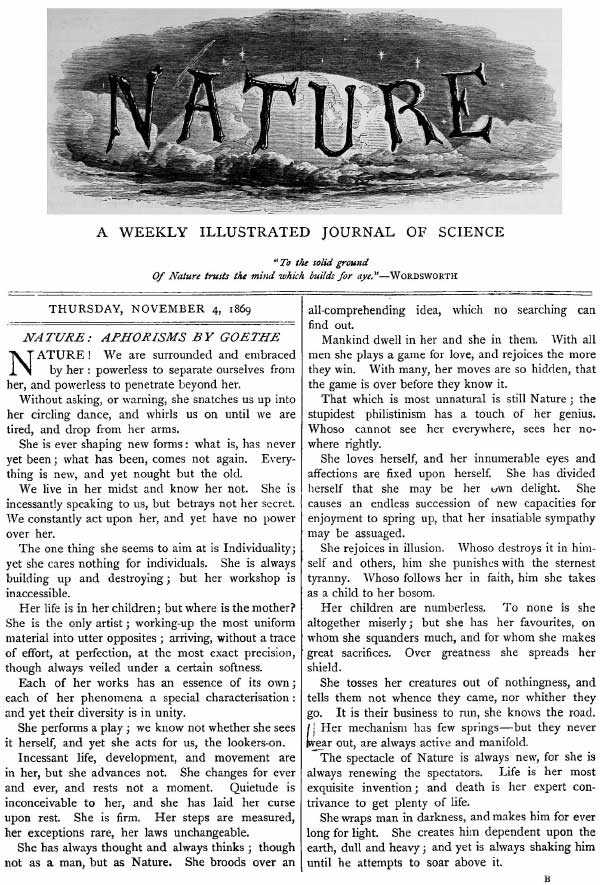
Журнал Nature сообщил об открытии трех новых научных сайтов свободного доступа. На двух из них будут публиковаться рецензируемые материалы по климатическим изменениям и стволовым клеткам, третий предназначен для быстрой публикации и предварительного обсуждения новейших научных результатов, еще не попавших в рецензируемые журналы.
С самого момента своего рождения в 1869 году журнал Nature ставил перед собой благородную цель, повторяемую с тех пор на каждой обложке журнала, — обеспечить культурному читателю широкий доступ к современным достижениям науки. Эта мысль, выраженная высоким стилем полуторавековой давности, остается актуальной и сейчас, но теперь времена меняются и журнал ищет новые пути к своей культурной читательской аудитории.
Самым надежным средством контакта между читающей публикой и журналом, накрепко и многообразно связанным с научным сообществом, сегодня являются бесплатные сайты журналов. Как правило, на сайтах рецензируемых журналов бесплатно можно читать только содержание, краткие резюме статей и некоторые редакционные материалы с завлекательными картинками. Не является исключением и журнал Nature. Оно и понятно — издание любого журнала, в том числе и научного, требует всё же редакционных и типографских затрат, и в большинстве случаев является вполне нормальным коммерческим проектом.
Однако сейчас уже совершенно ясно, что совмещение научно-просветительской деятельности с коммерцией и самоокупаемостью не всегда уместно. Сайты журналов постепенно становятся своеобразными просветительскими центрами и местами научных дискуссий. Появилось движение за создание бесплатных электронных научных журналов (таких, например, как журналы серии PLoS).
И вот Nature открывает специальные сайты свободного доступа, посвященные двум самым горячим научным темам. Это глобальные изменения климата и исследование стволовых клеток. Оба сайта содержат рецензируемый материал: научные статьи, обзоры научных публикаций Nature, краткие новости из других журналов, интервью и экспертные комментарии к самым острым научным публикациям. В общем, всё то, что может понадобиться пытливому читателю, желающему вникнуть в тематику и следить за ходом научного и общественного мнения по этим двум вопросам.
Редактором первого выпуска сайта по стволовым клеткам стал Ян Вилмут (Ian Wilmut) — лидер шотландской команды, породившей знаменитую овечку Долли. В его прекрасном популярном изложении читатель может узнать о том, как и зачем ученые пытаются пересадить ядро человеческой клетки в клетку животного, то есть создать специфическую клеточную химеру. Было бы желание узнавать!
На сайте есть и изнанка научных статей, материалы, позволяющие проследить, как идет исследовательская мысль, какие трудности исследования были припрятаны, что замалчивалось, как ученый спорил с въедливыми и, как правило, анонимными рецензентами, к которым статья попала на отзыв, и что было в конце концов опубликовано. Самые острые публикации текущего месяца будут предъявляться читателю вместе с вопросами и возражениям рецензентов и ответами на эти возражения. Безусловно, такая форма знакомства читателя с наукой имеет смысл. Читатель ведь редко является специалистом в рассматриваемом вопросе, и не всегда видит узкие места изложения. А анонимный рецензент укажет на них.
Третий новый сайт совсем другой, и цели у него другие. Он называется Nature Precedings. Как явствует из названия, там будут публиковаться предварительные материалы к исследованиям, неопубликованные результаты экспериментов, доклады на конференциях, тексты публичных лекций и т. д. Читатели смогут найти на этом сайте массу материалов, не вошедших по тем или иным причинам в основной пул научных публикаций, и получат возможность формально ссылаться на них. Создатели сайта предполагают, что авторам это даст возможность защитить свои авторские права при решении спорных вопросов приоритета.
Сайт будет публиковать материалы без официального рецензирования, однако они всё же будут просматриваться редакцией на предмет законности, научности и важности публикуемой информации. На публикацию материала на сайте будет уходить всего один рабочий день! Согласитесь, это для научной публикации рекордно короткий срок. В дальнейшем эта сырая информация будет подвергаться естественной сортировке: на сайте предусмотрена возможность голосования и комментирования.
Источник: Community service. Introducing three free-access websites for research networking and outreach // Nature. 2007. V. 447. P. 614.
Елена Наймарк
elementy.ru
Журнал "Nature" разрешат читать бесплатно
 Второго декабря 2014 г. издательство Macmillan объявило, что все исследовательские статьи, опубликованные в журнале Nature, можно будет прочесть в открытом доступе в специальном формате, предусматривающем возможность внесения заметок, но исключающем копирование, печать или загрузку файлов.
Второго декабря 2014 г. издательство Macmillan объявило, что все исследовательские статьи, опубликованные в журнале Nature, можно будет прочесть в открытом доступе в специальном формате, предусматривающем возможность внесения заметок, но исключающем копирование, печать или загрузку файлов.
Политика открытого доступа к содержанию журналов также распространится на 48 других журналов, публикуемых подразделением Macmillan’s Nature Publishing Group (NPG), включая Nature Genetics, Nature Medicine и Nature Physics. Это позволит ученым свободно читать статьи и делиться ссылками на них, сохранив основной источник дохода компании NPG – оплату доступа к публикуемым материалам, получаемую с библиотек и частных лиц.
Для размещения и отображения версий статей в формате PDF-файлов будет использована компьютерная программа ReadCube, аналогичная программе iTunes, выпускаемой компанией Apple. Если инициатива станет популярной, она может также повысить шансы ReadCube на распространение среди пользователей. Важно, что основные инвестиции в разработку этой программы сделала компания Macmillan.
По словам Аннетт Томас (Annette Thomas), исполнительного директора Macmillan Science and Education, согласно новой политике, подписчики смогут поделиться доступом к любой статье через ссылку на готовую к прочтению версию в формате PDF. Просмотреть статью можно будет через браузер. Для институтов-подписчиков это означает, что станут доступными любые статьи, начиная с момента основания журнала в 1869 г. Частные лица-подписчики получат доступ к статьям, опубликованным в журнале с 1997 г.
Каждый читатель сможет сделать репост и поделиться ссылкой на статью. Около 100 информационных агентств и блогов смогут распространить ссылку, позволяющую только прочесть PDF файлы. Несмотря на то, что просматриваемые на экране PDF-файлы нельзя распечатать, к ним можно будет оставить комментарии, что, по мнению издательства, поможет сотрудничеству ученых. Статьи в формате PDF также можно сохранить на бесплатной версии рабочего стола программы ReadCube аналогично тому, как музыкальные файлы можно сохранить в программе iTunes.
«Мы знаем, что ученые уже делятся содержанием журналов, часто используя тайные уголки в Интернете или с помощью неудобных и времязатратных методов», – говорит Тимо Ханнай (Timo Hannay), управляющий директор компании Digital Science – отделения издательства Macmillan. По словам Ханнай, компания Digital Science располагает технологией, которая представляет собой удобную и законную альтернативу, позволяющую исследователям получать нужную информацию и обеспечивающую заинтересованную общественность доступом к научным знаниям из достоверного оригинального источника.
Такая политика возникла в связи с тем, что организации, спонсирующие исследования, настоятельно требуют от ученых обеспечить бесплатное чтение и загрузку статей и их дальнейшее использование. Журнал Nature и дочерние журналы уже позволяют ученым свободно знакомиться он-лайн со статьями, прошедшими экспертную оценку, в том случае, если выход печатной версии статьи задерживается на шесть месяцев. По словам Томас, статьи, публикуемые в некоторых журналах NPG, составляющие 38% всех статей публикуемых издательством, можно бесплатно прочесть сразу после их опубликования. Это – «золотая модель открытого доступа», при которой доход от каждой статьи приносят авторы или их спонсоры, а не подписчики на журнал.
По словам Томас, модель подписки на журнал и модель получения дохода с открытого доступа к статьям будут сосуществовать в течение долгого периода времени. Филип Кэмпбелл (Philip Campbell), ответственный редактор журнала Nature и дочерних журналов, говорит, что внутренние расходы на публикацию статьи составляют 20-30 тыс. фунтов стерлингов (31-47 тыс. долларов США). По его мнению, это – крайне высокая цена для авторов и их спонсоров, поэтому ее удобнее распределить среди подписчиков журнала.
Первоначальная оценка общественностью новой политики издательства была противоречивой. Некоторые специалисты отметили, что она не позволяет получить полный доступ к статьям. По мнению Джона Вилбанкса (John Wilbanks), поддерживающего модель открытого доступа к научным статьям, члена фонда Ewing Marion Kauffman Foundation (Канзас Сити, США), данная политика больше похожа на политику связей с общественностью, а не на открытый доступ к материалам.
По словам Питера Субера (Peter Suber), директора Office for Scholarly Communication at Harvard University (США), эта программа представляет собой первый шаг в направлении обеспечения немедленного бесплатного он-лайн доступа к статьям. Однако, если автор предпочитает делиться ссылками, а не размещать свои статьи в он-лайн хранилище, программа может стать шагом назад, поскольку хранилища содержат копии файлов независимо от издателя. Эти копии можно напечатать или сохранить, а также обычно их можно повторно использовать, что отличает их от файлов, которые можно читать только с экрана.
По словам Томас, издание вводит вышеописанную стратегию в качестве пилотного проекта и будет оценивать результаты ее внедрения в течение следующего года. По мнению Томас, библиотеки и частные пользователи продолжат подписываться на журнал, но ученые также подхватят новую модель распространения файлов. Другие научные издания, например, Wiley, используют программу ReadCube для отображения предварительных версий статей, поэтому, возможно, что аналогичная идея будет воспринята другими изданиями.
Журнал Nature обеспечит бесплатное прочтение своих статей он-лайн, опубликованных начиная с 1869 г., но эти статьи будет нельзя распечатать или загрузить на компьютер.
science.spb.ru
nature Википедия
Nature (в переводе с англ. — «Природа») — один из самых старых и авторитетных общенаучных журналов. Публикует исследования, посвящённые широкому кругу вопросов, в основном естественно-научной тематики.
История
Первый номер журнала Nature был издан 4 ноября 1869 года английским физиком сэром Джозефом Норманом Локьером, который оставался редактором журнала до 1919 года.
Nature редактируется в Великобритании издательством Nature Publishing Group и издаётся в Лондоне. У журнала есть также офисы в Нью-Йорке, Сан-Франциско, Вашингтоне, Токио, Париже, Мюнхене и Бэсингстоуке.
Тематика
Журнал ориентирован на научных работников, однако в начале каждого издания публикуется краткое популярное изложение важнейших публикаций. В колонке редактора и разделе «Новости» (англ. News Articles) сообщается о событиях, интересных специалистам во всех областях. Остальная часть журнала состоит из оригинальных исследований, предполагающих наличие у читателя специальных знаний в соответствующей области.
Влияние
Публикации в таких журналах, как Nature или Science, крайне престижны, так как статьи из них часто цитируются, а автор получает широкую известность и за пределами своей области науки. Так, импакт-фактор Nature в 2012 году был равен 38,597[1], то есть каждая статья за два года, прошедших после публикации, в среднем цитируется более 31 раза. В 2009 году вошёл в Список 100 самых влиятельных журналов биологии и медицины за последние 100 лет под № 1 и был назван Журналом Столетия.
Однако критерии отбора статей в Nature (как и в Science) чрезвычайно жёстки. Большинство направляемых в Nature статей отсеиваются ещё до стадии рецензирования, поскольку результаты исследований, описанные в предлагаемой к публикации статье, должны представлять существенное продвижение в той или иной области науки. Так, именно в Nature были опубликованы статьи:
- об открытии рентгеновских лучей (W. C. Röntgen. On a new kind of rays. // Nature. — 1896. — Т. 53, № 1369. — С. 274—276.)
- об экспериментальном обнаружении волновой природы электрона (C. Davisson and L. H. Germer. The scattering of electrons by a single crystal of nickel. Nature, 119 (1927) 558—560).
- об открытии нейтрона (J. Chadwick. Possible existence of a neutron. Nature, 129 (1932) 312).
- об открытии деления атомного ядра (L. Meitner, O. R. Frisch. Disintegration of uranium by neutrons: a new type of nuclear reaction. Nature, 143 (1939) 239—240).
- об открытии спиральной структуры ДНК (J. D. Watson and F. H. C. Crick. Molecular structure of Nucleic Acids: A structure for deoxyribose nucleic acid. Nature, 171 (1953) 737—738).
- о создании первого лазера (T. H. Maiman . Stimulated Optical Radiation in Ruby. Nature, 187 (6 August 1960) 493—494)[2].
- об обнаружении озоновой дыры над Антарктикой (J. C. Farman, B. G. Gardiner and J. D. Shanklin. Large losses of total ozone in Antarctica reveal seasonal ClOx/NOx interaction. Nature, 315 (1985) 207—210).
- про первое клонирование млекопитающего (овца Долли) (I. Wilmut, A. E. Schnieke, J. McWhir, A. J. Kind and K. H. S.Campbell. Viable offspring derived from fetal and adult mammalian cells. Nature, 385 (1997) 810—813).
- о расшифровке человеческого генома (International Human Genome Sequencing Consortium. Initial sequencing and analysis of the human genome // Nature. — 2001. — Т. 409, № 6822. — С. 860—921.).
В 2009 году 3 из 5 самых цитируемых в мире статей по биологии были напечатаны в журнале Nature[3].
Критика
Нобелевский лауреат по медицине 2013 года Рэнди Шекман при вручении ему премии заявил, что ведущие научные журналы, среди которых и Nature, мешают научному процессу, так как желание увидеть свою публикацию в ведущих журналах побуждает учёных «срезать углы» и заниматься тем, что считается модным, а не тем, что важнее для науки. Кроме того, по мнению Шекмана, проблема в том, что редакторы этих журналов являются не учёными, а издателями и их интересуют прежде всего шумиха, сенсация и фурор. Пообещал больше не отправлять свои статьи в журналы Nature, Cell и Science.[4]
Академик РАН Е. Д. Свердлов, кроме случая с Шекманом, также обращает внимание на инцидент с японскими учёными из Центра биологии развития Института физико-химических исследований (RIKEN), опубликовавшими в 2014 году в журнале две статьи с изложением итогов опытов над зрелыми клетками мышей, подвергавшихся различному роду стрессовых воздействий, включая погружение в кислоту — метод, получивший известность под названием «получение плюрипотентности, вызванной стимулом (англ.)русск.» (англ. stimulus-triggered acquisition of pluripotency, STAP), в ходе которых ими был обнаружен новейший способ преобразования клеток в эмбрионально-подобное (плюрипотентное) состояние. Данное исследование первоначально было высоко оценено мировым научным сообществом, поскольку являлось теоретическим и медицинским открытием и позволяло упростить получение стволовых клеток необходимых для пересадки. Однако в дальнейшем в ходе внутреннего расследования RIKEN было обнаружено, что Харуко Обокато (англ.)русск., являвшаяся ключевым лицом в группе исследователей, совершила крупный подлог с фотографиями и рисунками. Следствием этого стал отзыв публикаций и самоубийство научного руководителя исследования Ёсики Сасаи, решившегося на это чтобы сохранить лицо.[5]
Примечания
Литература
Ссылки
wikiredia.ru

